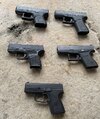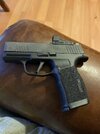Looking at some of the current and past options for small 9mms it's clear we have a lot of choices these days and everyone has an opinion on best for a variety of reasons. I wanted to see what was best in terms of controllability on the clock vs. the usual physical stats on paper or 'feels'.
The contenders we had on hand were G26, G43x, G43, PM9, Hellcat. All guns stock... except for the sights on the glocks which were all trijicon HDs or equivalent which match the hellcat OEM style (big dot up front). Ammo was 115gr Tula steel case because that's how I roll.

We didn't want the draw, presentation or movement variables in the data so none of that was on the clock to focus just on control. The drill was a simple 5 round string at an IDPA target at 8 yards. The thinking was that the first shot doesn't matter (you can shoot anything accurately once or slowly), the real delta would be in the controllability of the guns under sustained rapid fire. We used just the split times, and adjusted for misses. Sadly very few runs were clean, so either it wasn't my day or bill drills at 8 yards with subcompacts are hard. Or I suck, whatever.
In addition to the 5 guns themselves, for the G26 and the Hellcat we tried short mags with the pinkie dangling vs. an extended mag that allowed (me) to get a full grip. That gave us 7 sets of data, and I re-ran the 43x again since it was the first one and shot cold, wanted to see if me being warmed up would help. That gave us 16 total runs for these guys. Each gun was run twice back to back with the 43x sets both first and last.
The results were somewhat interesting but not unexpected. My EDC and former EDC were the fastest, and the ones I don't shoot much or weren't mine were not. Not really helpful except that training counts, which we already knew.
What was interesting was the pinkie dangling vs. full grip runs. For both the G26 and the Hellcat, same shooter same ammo same drill, the addition of the longer mag reduced split times by 10% across the board (and more for the Hellcat).
Sadly I didn't have my G34 on hand today to test as well, but I have lots of data on it from before so I'll just use that to draw conclusions:
- going from a full size down to a micro compact, I'm 35% slower
- going from a micro compact to a micro compact with a full length grip, I'm 10% faster
The 10% thing is the real win for the day. For both the G26 and the Hellcat, I can get an easier to conceal and carry package by carrying with the flush fit mags, or for a slightly harder to conceal package I can get 50% more ammo in the mag and a 10% speed boost. Same would hold for the G43 and G43x, a quantifiable advantage beyond just ammo capacity.
The contenders we had on hand were G26, G43x, G43, PM9, Hellcat. All guns stock... except for the sights on the glocks which were all trijicon HDs or equivalent which match the hellcat OEM style (big dot up front). Ammo was 115gr Tula steel case because that's how I roll.

We didn't want the draw, presentation or movement variables in the data so none of that was on the clock to focus just on control. The drill was a simple 5 round string at an IDPA target at 8 yards. The thinking was that the first shot doesn't matter (you can shoot anything accurately once or slowly), the real delta would be in the controllability of the guns under sustained rapid fire. We used just the split times, and adjusted for misses. Sadly very few runs were clean, so either it wasn't my day or bill drills at 8 yards with subcompacts are hard. Or I suck, whatever.
In addition to the 5 guns themselves, for the G26 and the Hellcat we tried short mags with the pinkie dangling vs. an extended mag that allowed (me) to get a full grip. That gave us 7 sets of data, and I re-ran the 43x again since it was the first one and shot cold, wanted to see if me being warmed up would help. That gave us 16 total runs for these guys. Each gun was run twice back to back with the 43x sets both first and last.
The results were somewhat interesting but not unexpected. My EDC and former EDC were the fastest, and the ones I don't shoot much or weren't mine were not. Not really helpful except that training counts, which we already knew.
What was interesting was the pinkie dangling vs. full grip runs. For both the G26 and the Hellcat, same shooter same ammo same drill, the addition of the longer mag reduced split times by 10% across the board (and more for the Hellcat).
Sadly I didn't have my G34 on hand today to test as well, but I have lots of data on it from before so I'll just use that to draw conclusions:
- going from a full size down to a micro compact, I'm 35% slower
- going from a micro compact to a micro compact with a full length grip, I'm 10% faster
The 10% thing is the real win for the day. For both the G26 and the Hellcat, I can get an easier to conceal and carry package by carrying with the flush fit mags, or for a slightly harder to conceal package I can get 50% more ammo in the mag and a 10% speed boost. Same would hold for the G43 and G43x, a quantifiable advantage beyond just ammo capacity.



